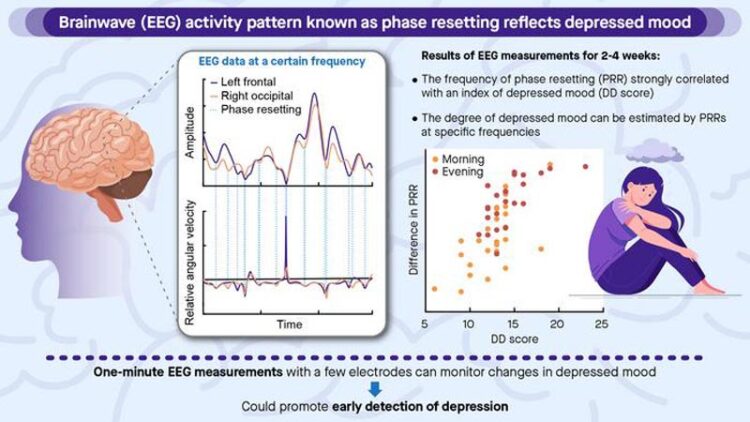Brainwave activity for assessing depressed mood in healthy people

Brainwave (EEG) activity pattern known as phase resettting reflects depressed mood
Credit: University of Tsukuba
Depression is a common but serious mental disorder that requires early diagnosis and treatment; however, it is currently difficult to do so. Electroencephalogram (EEG) is a test that easily measures electrical activity, and the equipment is relatively inexpensive, such that it may be used to promote the early detection and treatment of depression. However, such a method has not been developed.
The participants of this study were instructed to measure their EEG for 1 min every day at home across two to four weeks to investigate its relationship to the intensity of their depressed mood. The results demonstrated that the occurrence of phase resetting for many participants, in which brain waves from different brain regions synchronize, increased with high levels of depressed mood at certain frequencies but decreased at other frequencies.
These results indicate that changes in depressed mood can be objectively measured using EEG for 1 min in a resting state and are expected to facilitate the early detection of depression and the development of novel treatment in the future.
This work was supported by JSPS KAKENHI Grant Numbers JP18H03304 and JP23K17457 and by JKA through its promotion funds from KEIRIN RACE (2020M-117).
Original Paper
Title of original paper:
Brainwave activities reflecting depressed mood: a pilot study
Journal:
Scientific Reports
DOI:
10.1038/s41598-023-40582-y
Correspondence
Professor MORITA, Masahiko
Institute of Systems and Information Engineering, University of Tsukuba
Related Link
Institute of Systems and Information Engineering (in Japanese)
Media Contact
KAMOSHITA Kimio
University of Tsukuba
kohositu@un.tsukuba.ac.jp
www.tsukuba.ac.jp
Original Source
All latest news from the category: Health and Medicine
This subject area encompasses research and studies in the field of human medicine.
Among the wide-ranging list of topics covered here are anesthesiology, anatomy, surgery, human genetics, hygiene and environmental medicine, internal medicine, neurology, pharmacology, physiology, urology and dental medicine.
Newest articles
Faster, more energy-efficient way to manufacture an industrially important chemical
Zirconium combined with silicon nitride enhances the conversion of propane — present in natural gas — needed to create in-demand plastic, polypropylene. Polypropylene is a common type of plastic found…

Energy planning in Ghana as a role model for the world
Improving the resilience of energy systems in the Global South. What criteria should we use to better plan for resilient energy systems? How do socio-economic, technical and climate change related…

Artificial blood vessels could improve heart bypass outcomes
Artificial blood vessels could improve heart bypass outcomes. 3D-printed blood vessels, which closely mimic the properties of human veins, could transform the treatment of cardiovascular diseases. Strong, flexible, gel-like tubes…





















